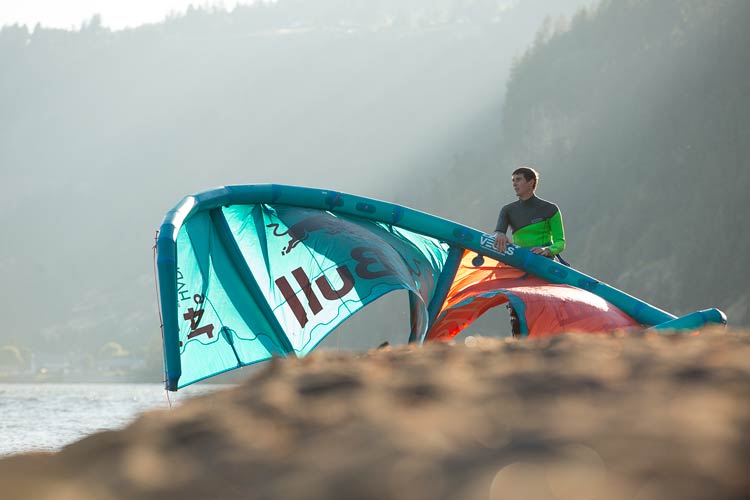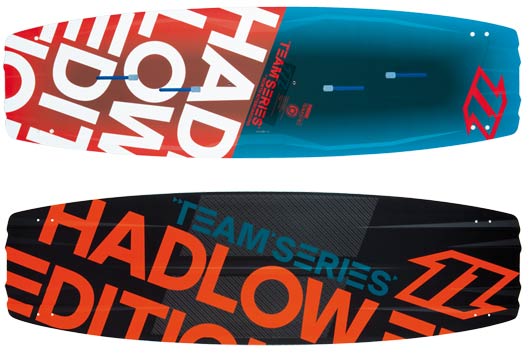Last month we had the first part of our interview with Aaron Hadlow, ex-5x World Champion – that focused on his return to competition and recovery from injury to win his first event of the PKRA season. Now we have the second part – Aaron made a big move this year to join North Kiteboarding (NKB) after 12 years with Flexfoil – so we had to ask him how being part of the one of the biggest kiteboarding companies is going and get all the details on his input into the new Vegas Pro kite and Hadlow Pro board…
Hadlow on Equipment
Rob: Onto the big thing of you joining North, how has that worked out, how’s it been suddenly being part of a big team and having what must be a lot more resources behind you? Both from a product point of view, but also from a marketing/PR side of things.
Aaron: The whole thing has been really cool, way better than I could have imagined. At the beginning of the year I was kind of a bit lost and I didn’t know where I’d be heading, what I’d be doing. At the time it was more about getting the right kites. Which turned out to be really really good, I’m actually happier with these kites now than I was with my old ones, now that I’m used to them. That was the biggest deal and the biggest thing for me but yeah the products have turned out really amazing and they are really helping me in what I’m trying to achieve. Then the general thing is just the bonus of having the backing of a huge company. I knew that from the beginning, but until you actually witness it and you’re a part of it, it’s hard to really know. Now everything is starting to kick off, I did really well in Germany, but just from that instance I really see how much NKB promote it and how happy they are with that result. Then with the adverts, launching the new kites and just in general it will really help grow my profile. After the photoshoots, already within a month we got three front covers. It’s the whole bigger picture of self promotion, all that stuff that I used to really struggle to do on my own is all just laid on a plate for me.
R: Do you find that you can concentrate more on your riding and actually trying to win?
A: Yeah definitely. It’s different now. When I’m on my computer I’m working on more rider oriented stuff. For anything to do with the company I know it doesn’t have to be a finished product, just the basic info for the guys in the office to work with, it doesn’t have to be complete and that is what usually takes up most of the time.
I mean sometimes I don’t have to do anything at all and I still see something being published, something cool online, or a video just dropped in. It gives me time; I still enjoy focusing on the testing, development and marketing as I like to be involved wherever I can, so that I can steer the image in the right direction. But I’m given the equipment and everything I need to just go and ride and do what I gotta do. I’m definitely really happy in the position that I’m in at the moment, it’s only really the start and it’s already really good.
R: What’s the top, number one feature about your kite and your new board that you see as a big improvement over what you’ve had before?
A: Compared with the last one. I guess the overall performance and I like the fact that the Vegas does the same job as what my two Hadlow kites used to do in the past (Pro and ID). It de-powers as much as an ID [Flexi Hadlow ID kite] and it re-launches better than both, but then it still can be trimmed to the point where I need it to work like my old main kite (Pro), it’s just an all-round more user friendly kite.

But from my personal point of view, for the stuff that I do, the kite is crisper turning, really direct, and also the way the kite is made, it’s quite a bit lighter. Everything is really in the detail and to the millimetre, I don’t feel any twisting, no flutter and when it moves, it moves in the right way and it’s positive. Then when doing tricks the kite actually drives forward really well, it doesn’t have that tendency to back-stall, which a lot of these type of kites have tendency to do. So for toeside tricks, for instance, it really helps when I can just unhook, bare off downwind and not have the kite fold backwards at all, it just sits there, moves back in the window a bit and then when I edge it just shoots forward and that’s how I create my pop. So, it’s helping for that.
Then just the general pop and slack in the kite for the double handle passes it’s more consistent, I used to get a real initial thump from my old kites and then there would be a really slack period, but quite late into the move, now with the new kites I can go quicker into my first spin and still have lighter pressure for the second pass.
I kind of felt like I was at my limit of progressing with my old Hadlow Pro kite and I couldn’t get anything more out of it. With my new ones, I feel I’m at the same level or better in terms of riding plus there’s way more potential to move forward with it.
R: Brilliant. How many prototypes did you test because you obviously came in during the winter, they’d already started playing around with the idea of a pro version of the Vegas. How many prototypes did you get to go through.
A: I saw the kite and it was already in a real nice shape. I knew it would be a great base to work from. The actual design from what you can see hasn’t changed that much but where I came in was more in the finer details of the profile and the setups on the toe points etc. The actual kite was solid, it had no wrinkles, no flutter, and they had widened the new tip design so it was a lot squarer, this got me really interested. Knowing Ralf (NKB kite designer) better now I can see this was a standard that had to, and had always, been met by himself and North.
I tested maybe two or three rounds of prototypes to get it to the point where I was really happy with it, then I think Ralf refined a few things to complete the commercial set up. That was the production one.
So there was a few small change to the big white Red Bull kites they had at the beginning of the season to my final production ones. There were some small tweaks, but it was more for the characteristics of the way the canopy sits and just to smooth out everything so that it was a real nice looking kite, no wrinkles or any problems.
R: And what about your board, how did that come about?
A: I was actually quite scared at the beginning that I wouldn’t be able to adapt to their style of boards because they are really quite different to what I was used to. They’ve always been quite flexible, and just a totally different outline and concept to the way that I’ve always ridden. My old boards were really quite thick, really stiff, and with a real rounded outline. So, the development for that I found challenging.
They gave me the new version of the team series, I jumped on it and I quite liked it, but it was very different and it was quite hard to adapt. There was one major benefit, and positive, I could really work with though, the construction. I had a lot more pop from their construction because they use carbon in a particular flex pattern. I could pop noticeably bigger because of the way they laid them up.

The Hadlow Edition board did actually take quite a bit more time and feedback to get it right. I was still looking for it to be stiffer and also a slightly rounder outline because I was struggling to release the edge at the right time (for me). It had a little bit of torsion twists so that when you did some tricks with a heavy edge, the board would stick to the water and I could never really find the release at the right time.
We ended up stiffening the board through the centre to eliminate some torsion and also help with heavy landings which stops the board moulding to the water or doing anything funny when you land. Also with the combination of more rocker and a slightly more rounded outline I was able to really get the right setup for the board. Now I’m used to the board and now we’ve found the right combination of things, it’s really something that I can feel is working way better for me.
After visiting the factory and learning so much from the guys, I really have changed the way I think about boards, a combination of things I learnt in the past and the things I am learning now really makes for something special.
R: A lot of people will probably think that in such a short period of time since you came onboard that it’s just a re-branded T-Series or Gambler or something like that, but you really have tweaked it quite heavily to fit in the way that you want to ride.
A: Yeah I mean in the end my testing brought a lot over to the team series, so if you look at the team series this year and my edition, there isn’t a huge difference. It’s more the outline and a little bit in the flex. But my general feedback was also something that the other team riders usually pushed for themselves too, these changes seem to work best for this style of board.
If you look from last years team series to this years team series then there’s a huge change, it’s totally re-designed. Bigger channels, way stiffer, thicker, and then obviously my edition is again a bit more developed, it’s not like the kite where its the same kite with different graphics, it has it’s unique outline and sizing and so on.

It’s just how you prefer your riding style, some people like the squarer board and some people get on my board with a little bit more rounded outline prefer that. It just gives a little more of a wider audience to that type of customer.
It’s a combination of everything working together and we worked hard on getting the right flex pattern for that board in combination with the new kite. It is all linked and ultimately my set up allows me to do what I need it to do and better than ever before.
So there you have it, as you can see someone with Aaron’s experience is very specific about what he wants from his kite and board, I for one find it really interesting to hear about how the products we use get developed and the problems they are trying to solve.
Thanks to Aaron for his time and you can follow him as he trains this winter in Cape Town ready for the PKRA in 2015. Also you can follow North Kiteboarding for all all the updates from their team.
If you’re interested in learning unhooked powered freestyle tricks then the Progression Professional Collection / DVD, or one of the individual videos, could save you many sessions of hard crashes! Or simply allow you to apply some of Aaron’s trademark style into your tricks.
